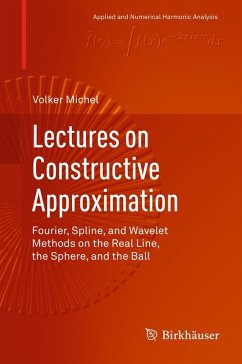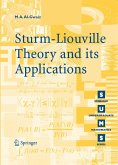Lectures on Constructive Approximation: Fourier, Spline, and Wavelet Methods on the Real Line, the Sphere, and the Ball focuses on spherical problems as they occur in the geosciences and medical imaging. It comprises the author's lectures on classical approximation methods based on orthogonal polynomials and selected modern tools such as splines and wavelets.
Methods for approximating functions on the real line are treated first, as they provide the foundations for the methods on the sphere and the ball and are useful for the analysis of time-dependent (spherical) problems. The author then examines the transfer of these spherical methods to problems on the ball, such as the modeling of the Earth's or the brain's interior. Specific topics covered include:
* the advantages and disadvantages of Fourier, spline, and wavelet methods
* theory and numerics of orthogonal polynomials on intervals, spheres, and balls
* cubic splines and splines based on reproducing kernels
* multiresolution analysis using wavelets and scaling functions
This textbook is written for students in mathematics, physics, engineering, and the geosciences who have a basic background in analysis and linear algebra. The work may also be suitable as a self-study resource for researchers in the above-mentioned fields.
Methods for approximating functions on the real line are treated first, as they provide the foundations for the methods on the sphere and the ball and are useful for the analysis of time-dependent (spherical) problems. The author then examines the transfer of these spherical methods to problems on the ball, such as the modeling of the Earth's or the brain's interior. Specific topics covered include:
* the advantages and disadvantages of Fourier, spline, and wavelet methods
* theory and numerics of orthogonal polynomials on intervals, spheres, and balls
* cubic splines and splines based on reproducing kernels
* multiresolution analysis using wavelets and scaling functions
This textbook is written for students in mathematics, physics, engineering, and the geosciences who have a basic background in analysis and linear algebra. The work may also be suitable as a self-study resource for researchers in the above-mentioned fields.
Dieser Download kann aus rechtlichen Gründen nur mit Rechnungsadresse in A, B, BG, CY, CZ, D, DK, EW, E, FIN, F, GR, HR, H, IRL, I, LT, L, LR, M, NL, PL, P, R, S, SLO, SK ausgeliefert werden.
From the reviews:
"The textbook Lectures on constructive approximation teaches the basics and details of Fourier, spline, and wavelet methods on the real line, the sphere, and the ball. ... The style of the book is clearly that of a textbook, since the author makes a great effort to make very complicated concepts comprehensible to the reader. Throughout the book, numerous numerical examples and graphical illustrations support the explanations. This book is appropriate for applied mathematicians and numerical analysts as well as for geoscientists and engineers." -- Willi Freeden, Mathematical Reviews, August, 2013
"The textbook Lectures on constructive approximation teaches the basics and details of Fourier, spline, and wavelet methods on the real line, the sphere, and the ball. ... The style of the book is clearly that of a textbook, since the author makes a great effort to make very complicated concepts comprehensible to the reader. Throughout the book, numerous numerical examples and graphical illustrations support the explanations. This book is appropriate for applied mathematicians and numerical analysts as well as for geoscientists and engineers." -- Willi Freeden, Mathematical Reviews, August, 2013
From the book reviews:
"This is a constructive approach to approximation by Fourier series (orthogonal polynomials), splines and wavelets. ... The basis functions are illustrated with many color plots and the proofs are fully written out. ... This is a clear introduction to subjects that are not easily found in other textbooks at this level. Obviously it is of interest for geophysical applications." (Adhemar Bultheel, zbMATH, Vol. 1295, 2014)
"The textbook Lectures on constructive approximation teaches the basics and details of Fourier, spline, and wavelet methods on the real line, the sphere, and the ball. ... The style of the book is clearly that of a textbook, since the author makes a great effort to make very complicated concepts comprehensible to the reader. Throughout the book, numerous numerical examples and graphical illustrations support the explanations. This book is appropriate for applied mathematicians and numerical analysts as well as for geoscientists and engineers." (Willi Freeden, Mathematical Reviews, August, 2013)
"This is a constructive approach to approximation by Fourier series (orthogonal polynomials), splines and wavelets. ... The basis functions are illustrated with many color plots and the proofs are fully written out. ... This is a clear introduction to subjects that are not easily found in other textbooks at this level. Obviously it is of interest for geophysical applications." (Adhemar Bultheel, zbMATH, Vol. 1295, 2014)
"The textbook Lectures on constructive approximation teaches the basics and details of Fourier, spline, and wavelet methods on the real line, the sphere, and the ball. ... The style of the book is clearly that of a textbook, since the author makes a great effort to make very complicated concepts comprehensible to the reader. Throughout the book, numerous numerical examples and graphical illustrations support the explanations. This book is appropriate for applied mathematicians and numerical analysts as well as for geoscientists and engineers." (Willi Freeden, Mathematical Reviews, August, 2013)









